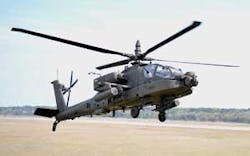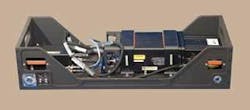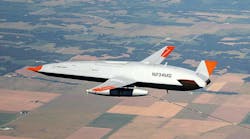By John McHale
FORT EUSTIS, Va.–Officials at the Army Aviation Applied Technology Directorate (AATD) at Fort Eustis, Va., asked engineers at Lockheed Martin Missiles and Fire Control in Orlando, Fla., to quicken the response time of AH-64 Apache attack helicopters on the battlefield by integrating unmanned aircraft system (UAS) video.
This initiative involves shortening the “kill chain” for the Apache helicopter, which Army leaders want finished in less than a year. The kill chain refers to the sequence of events that must occur for the Apache helicopter to engage and kill its target. These events include surveillance, identification, acquisition, guidance, and destroying the target.
The project is called Apache Video from Unmanned Aircraft Systems for Interoperability Teaming–Level 2 (VUIT-2), says Bill Murtha, VUIT-2 program manager at Lockheed Martin Missiles and Fire Control. This effort is an example of how U.S. Department of Defense leaders have pushed aside funding in years for long-term programs to get equipment and technology into the field quickly to help the troops in Iraq and Afghanistan.
The VUIT-2 was designed to be independent of the aircraft avionics, which helped cut down on development time, says Greg Walker, VUIT-2 business development manager at Lockheed Martin. It requires “minimum modification to the aircraft.”
Shortening the kill chain is the result of teaming manned and unmanned systems to provide intelligence, surveillance, and reconnaissance data, Murtha says. Real-time UAS targeting video streamed to the Apache pilots and gunners reduces the time from sensor to shooter. Apache operators can slew their sensors quickly to adjust to UAS target positions. The VUIT-2 displays the UAS video, map, metadata–target location–in the cockpit, then retransmits it to the ground. Ground units can see the video in real-time, enabling rapid target validation so commanders can authorize target destruction, he adds.
For example, an unmanned aircraft looking for targets for Apache attack helicopters transmits the target video and map to the helicopter, Murtha says. The Apache pilot then uses the VUIT-2 video panel interface in the cockpit to analyze the incoming data, proceeds to fire its missiles, then watches the streaming UAS video to verify the target’s destruction–all while remaining out of enemy weapons range, he explains.
The ground link to the UAS video and the Apache sensor suite is through the VUIT-2 mini-tactical common data link (TCDL). Soldiers collect and validate the information with a one system remote video terminal (OSRVT) or similar equipment, Murtha says. Camber’s Sensor Systems division in Dallas designed and manufactured the video panel interface, while the VUIT-2 tactical visual computer is a Thermite computer from Quantum3D in San Jose, Calif. The receiver assembly includes a UHF modem and OSRVT from AAI Corp. in Hunt Valley, Md.
The VUIT-2 also takes advantage of existing video recorders, switches, and antennas on the Apache, Murtha says. The VUIT-2 tri-band omni-directional mast mounted assembly (TOMMA) and right extended forward avionics bay (EFAB) chassis video receiver (RCVR) assembly enable the video feed on the Apaches.
UASs transmitting video include Shadow, Raven, Hunter, Predator, Warrior A, Reaper, and other systems. VUIT-2 also enables the Apache to receive video from other aircraft, such as the U.S. Air Force F-15s, F-16s, and A-10s, and U.S. Navy F-18s that have advanced targeting pods such as the Lockheed Martin Sniper, Murtha says.
“The F-15s and F-16s with Sniper provide day and night imagery to locate armed insurgents and guide weapons toward targets,” says Mark Fischer, Sniper ATP business development manager at Lockheed Martin Missiles and Fire Control. Future Sniper variants will also provide convoy route and improvised explosive device (IED) sweeps, battle damage assessment, and high-value asset surveillance, Fischer adds.
The VUIT-2 system comes in 2 kits–A and B. All battalion aircraft receive the VUIT-2 A-kits, which require permanent cabling and structural modifications, as well as a mini tactical datalink for downloading and control to ground units, Murtha says. Nine of the 24 will also get the B-Kits, which use line-replaceable units to provide UAS video display and receive capability. The capability will also be extended to other rotary wing platforms. Manned-unmanned teaming through the VUIT-2 will be used to provide “immediate surveillance of landing zones and over watch protection,” he says.
Planned upgrades to the VUIT-2 system will provide future interface with the Apache Block III UAS Tactical Common Data Link Assembly scheduled for fielding in 2011. The next spiral of the program will provide video sharing between aircraft and two-way video ground stations, Walker says.





